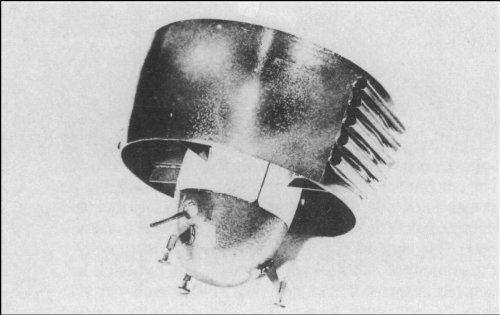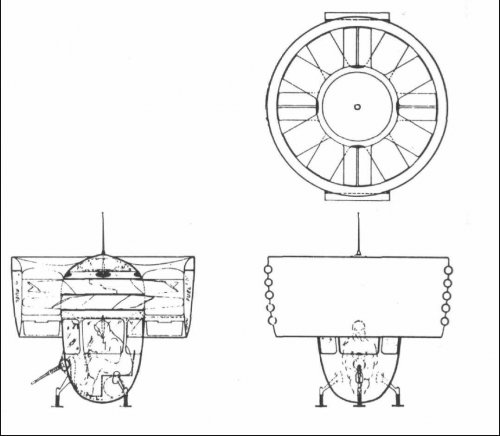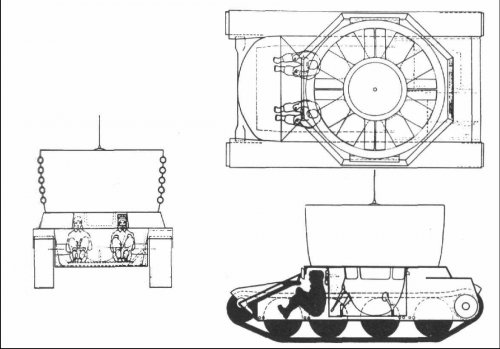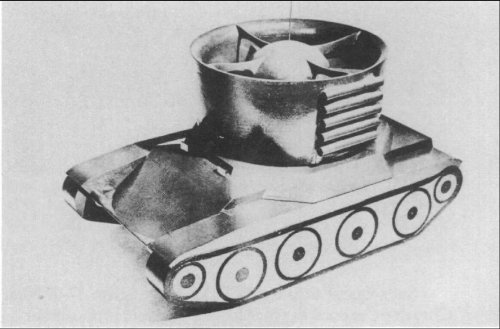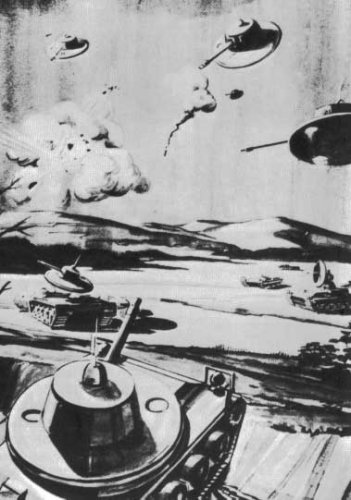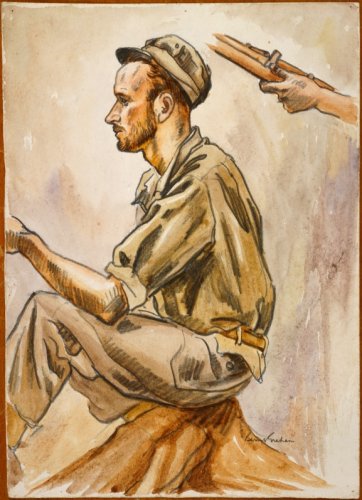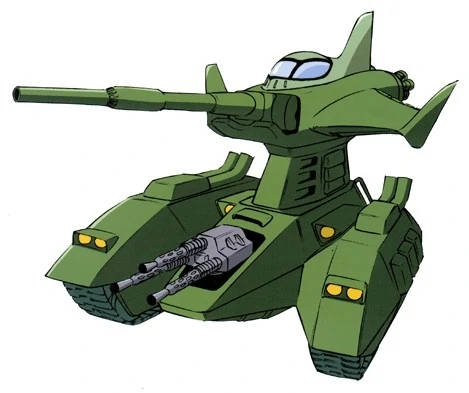You are using an out of date browser. It may not display this or other websites correctly.
You should upgrade or use an alternative browser.
You should upgrade or use an alternative browser.
- Joined
- 1 April 2006
- Messages
- 11,358
- Reaction score
- 10,113
Skybolt, you are reading my brains - just was going to post it.
The Ordnance Tank Automotive Command (OTAC)
presented two programs in response to the requirements
of the ASTRON project. The first was based on technology
that was only slightly advanced beyond what was available
at that time, while the second program utilized a level
of technology that could be expected by 1962, provided
that high priorities were placed on the development of
certain components.
The first program consisted of proposals for a new
medium gun tank and two specialized combat vehicles. The
latter were a ten ton airborne light tank and a one man
armored reconnaisance aircraft with a tracked carrier. As
presented on 17 May 1955, the medium gun tank was
referred to as the Rex. Later, it was redesignated as the
Rex I after the development of subsequent versions.
The Rex tank incorporated many of the features
included in some of the earlier proposals. The driver was
located in the turret with the gunner and the tank commander.
The turret ring was only 80 inches in diameter,
but this provided ample space since an automatic loading
device replaced the loader reducing the crew to three men.
The gunner and tank commander were in their usual positions
on the right side of the rigidly mounted modified
90mm gun T208 and the tank commander was provided
with a cupola armed with a .30 caliber machine gun. This
was part of an integrated commander's station including
an Optar range finder, a sight, and an automatic target
designation system. The latter held the cupola and its sight
on a target while the turret and gun were traversed and
brought to bear on the same target. The correct superelevation
was automatically applied to the main armament
during this operation. The 90mm gun T208 was modified
to use combustible case ammunition eliminating the need
for a case ejection mechanism and simplifying the design
of the automatic loader. This loader was supplied by a 14
round rotary magazine underneath the turret basket floor
which could be reloaded when needed by the tank commander
or driver. The estimated maximum firing rate with
the automatic loader was 28 to 30 rounds per minute. A
coaxial .50 caliber machine gun was mounted on the left
side of the cannon and an articulated telescopic sight was
located on the right side for the gunner. No stabilization
was provided for the main armament.
The driver was seated on a platform suspended from
the roof in the left front of the turret. His seat was hydraulically
adjustable between a low position for use when the
hatch was closed to a high position for operation with the
driver's head exposed. A gear train rotated the driver's platform
so that he always faced forward regardless of the turret
position. The linkages for the driver's controls were actuated
by electrical signals transmitted through slip rings.
The turret location provided the driver with a greatly
increased field of vision allowing him to maneuver the tank
even in reverse without aid from another observer. He also
was less vulnerable to dirt and water splash as well as mine
explosions. Protection for the entire crew compartment
against chemical, biological, and radiological (CBR) attack
was provided by a single unit so that the wearing of
individual masks was not required.
The front of the turret and hull was protected from
attack in the 60 degree frontal arc by siliceous cored armor.
This armor was effective against shaped charge rounds up
to 100mm in diameter. Against armor piercing kinetic
energy projectiles, it was equivalent to 4.8 inches of
homogeneous steel armor at 60 degrees from the vertical.
The combat loaded weight of the Rex was estimated to be
31 tons and it was to be powered by a transversely mounted
Continental AOI-628 engine with the XTG-400 transmission.
This version of the engine was expected to deliver
a maximum of 350 gross horsepower. The flat track torsion
bar suspension had four dual road wheels per side
with 19 inch wide tracks. The driver-in-turret design
resulted in an overall height of only 95 inches for the Rex.
The width was 126 inches and the overall length with the
gun forward was 348 inches.
The most radical of all of the proposals under the first
OTAC program was the one man armored reconnaisance
aircraft. A vertical take off and landing vehicle with the
flying characteristics of a helicopter, it was designed to
be carried by and launched from a tracked carrier based
on the Rex tank. The aircraft portion of this combination
was called Falcon and the tracked vehicle was appropriately
named Aerie.
Powered by an aircraft radial engine, the 113 inch
diameter flying vehicle was protected by one inch thick
titanium armor. Armed with ten 4.5 inch free flight rockets
and a .30 caliber machine gun, the estimated weight of
the Falcon was 3000 pounds. Its speed range was calculated
to vary from 0 (hover) to 100 miles per hour with
an endurance of about one hour. An emergency parachute
installed at the top center of the aircraft was expected to
be capable of providing a safe landing from an altitude as
low as 100 feet.
The Aerie carrier alone was estimated to weigh 20 tons
with space in the front hull for a two man crew. It was
fitted with a hydraulically retractable take off platform for
the Falcon.
The Ordnance Tank Automotive Command (OTAC)
presented two programs in response to the requirements
of the ASTRON project. The first was based on technology
that was only slightly advanced beyond what was available
at that time, while the second program utilized a level
of technology that could be expected by 1962, provided
that high priorities were placed on the development of
certain components.
The first program consisted of proposals for a new
medium gun tank and two specialized combat vehicles. The
latter were a ten ton airborne light tank and a one man
armored reconnaisance aircraft with a tracked carrier. As
presented on 17 May 1955, the medium gun tank was
referred to as the Rex. Later, it was redesignated as the
Rex I after the development of subsequent versions.
The Rex tank incorporated many of the features
included in some of the earlier proposals. The driver was
located in the turret with the gunner and the tank commander.
The turret ring was only 80 inches in diameter,
but this provided ample space since an automatic loading
device replaced the loader reducing the crew to three men.
The gunner and tank commander were in their usual positions
on the right side of the rigidly mounted modified
90mm gun T208 and the tank commander was provided
with a cupola armed with a .30 caliber machine gun. This
was part of an integrated commander's station including
an Optar range finder, a sight, and an automatic target
designation system. The latter held the cupola and its sight
on a target while the turret and gun were traversed and
brought to bear on the same target. The correct superelevation
was automatically applied to the main armament
during this operation. The 90mm gun T208 was modified
to use combustible case ammunition eliminating the need
for a case ejection mechanism and simplifying the design
of the automatic loader. This loader was supplied by a 14
round rotary magazine underneath the turret basket floor
which could be reloaded when needed by the tank commander
or driver. The estimated maximum firing rate with
the automatic loader was 28 to 30 rounds per minute. A
coaxial .50 caliber machine gun was mounted on the left
side of the cannon and an articulated telescopic sight was
located on the right side for the gunner. No stabilization
was provided for the main armament.
The driver was seated on a platform suspended from
the roof in the left front of the turret. His seat was hydraulically
adjustable between a low position for use when the
hatch was closed to a high position for operation with the
driver's head exposed. A gear train rotated the driver's platform
so that he always faced forward regardless of the turret
position. The linkages for the driver's controls were actuated
by electrical signals transmitted through slip rings.
The turret location provided the driver with a greatly
increased field of vision allowing him to maneuver the tank
even in reverse without aid from another observer. He also
was less vulnerable to dirt and water splash as well as mine
explosions. Protection for the entire crew compartment
against chemical, biological, and radiological (CBR) attack
was provided by a single unit so that the wearing of
individual masks was not required.
The front of the turret and hull was protected from
attack in the 60 degree frontal arc by siliceous cored armor.
This armor was effective against shaped charge rounds up
to 100mm in diameter. Against armor piercing kinetic
energy projectiles, it was equivalent to 4.8 inches of
homogeneous steel armor at 60 degrees from the vertical.
The combat loaded weight of the Rex was estimated to be
31 tons and it was to be powered by a transversely mounted
Continental AOI-628 engine with the XTG-400 transmission.
This version of the engine was expected to deliver
a maximum of 350 gross horsepower. The flat track torsion
bar suspension had four dual road wheels per side
with 19 inch wide tracks. The driver-in-turret design
resulted in an overall height of only 95 inches for the Rex.
The width was 126 inches and the overall length with the
gun forward was 348 inches.
The most radical of all of the proposals under the first
OTAC program was the one man armored reconnaisance
aircraft. A vertical take off and landing vehicle with the
flying characteristics of a helicopter, it was designed to
be carried by and launched from a tracked carrier based
on the Rex tank. The aircraft portion of this combination
was called Falcon and the tracked vehicle was appropriately
named Aerie.
Powered by an aircraft radial engine, the 113 inch
diameter flying vehicle was protected by one inch thick
titanium armor. Armed with ten 4.5 inch free flight rockets
and a .30 caliber machine gun, the estimated weight of
the Falcon was 3000 pounds. Its speed range was calculated
to vary from 0 (hover) to 100 miles per hour with
an endurance of about one hour. An emergency parachute
installed at the top center of the aircraft was expected to
be capable of providing a safe landing from an altitude as
low as 100 feet.
The Aerie carrier alone was estimated to weigh 20 tons
with space in the front hull for a two man crew. It was
fitted with a hydraulically retractable take off platform for
the Falcon.
Attachments
- Joined
- 14 June 2006
- Messages
- 2,300
- Reaction score
- 550
By 1963 the flying turrets had acquired a real gun... From Army Information Digest 1963...  An artcle on the Army Combat Developments Command
An artcle on the Army Combat Developments Command
And in Project Question Mark they devised even flying trucks... But all these things deserve separate topics, fellows! Let's stick to the original topic (nuclear tanks) here... ;D
BTW Pometablava, how the giving is going?
And in Project Question Mark they devised even flying trucks... But all these things deserve separate topics, fellows! Let's stick to the original topic (nuclear tanks) here... ;D
BTW Pometablava, how the giving is going?
Attachments
- Joined
- 8 January 2006
- Messages
- 1,608
- Reaction score
- 754
Yeah, according to the book on light tanks published by Presidio Press, it was abandoned because the US Army wanted one that could ford rivers and ended up going with what became the M551 Sheridan.
Matej
Multiuniversal creator
Matej
Multiuniversal creator
See the reply no. 1 in this thread written by flateric 
- Joined
- 25 June 2009
- Messages
- 14,718
- Reaction score
- 6,041
Did you notice the shape of the flying turrets in Skybolt's post?
Remove the gun and you almost have an exact copy of the most often photographed UFOs!
I'm not saying there's a connection, though... :
Remove the gun and you almost have an exact copy of the most often photographed UFOs!
I'm not saying there's a connection, though... :
Matej
Multiuniversal creator
flateric said:seems to me that I can clearly recognize the face profiles of the crew...
Attachments
- Joined
- 3 June 2011
- Messages
- 18,296
- Reaction score
- 12,109
Matej said:
That top piece would only work if it made a flying saucer sound "whoop-whoop-whoop-whoop-whoop" ;D
Dilandu
I'm dissatisfied, which means, I exist.
- Joined
- 9 October 2009
- Messages
- 21,927
- Reaction score
- 13,526
From 1968:

US AFV Concepts NO.7 – AERIAL ASSAULT VEHICLE
CONCEPT NO.7 AERIAL ASSAULT VEHICLE – MISSILE/ROCKET Concept Description and Design Rationale (C) This concept shows a one-man Arial Assault Vehicle, mounting four missiles. The purpose of th…fromtheswedisharchives.wordpress.com
LogicalEnemyResponse
ACCESS: Restricted
- Joined
- 13 December 2019
- Messages
- 10
- Reaction score
- 9
I wanted to add there are some incredible computer generated images by C. Sundiata Cowels(samratek)in the March/April 2019 issue of Vertiflite magazine along with a 3 page article,lots of three-views,and great information regarding armament and armor plating. It even has an interior view of the pilots seat.
Attachments
Last edited:
Similar threads
-
-
-
-
-
U.S. Army Armored Gun System program (early 1980s)
- Started by Grey Havoc
- Replies: 8

